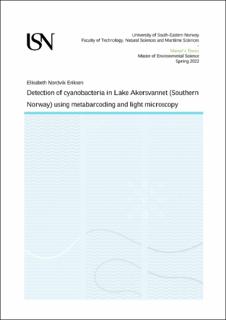| dc.description.abstract | Cyanobacteria can be found in freshwater and drinking water systems almost all over the world and with climate change and increasing temperature and precipitation, cyanobacterial growth and blooms are favoured. One important concern related to cyanobacteria, is occurrence of cyanobacteria with abilities to produce metabolites and toxins which can be harmful to animals and humans. Some Norwegian lakes experience sporadic or annual cyanobacterial blooms, one of whom is Lake Akersvannet in Vestfold and Telemark County, in Southern Norway. Traditionally, inverted light microscope are used for quantitative and qualitative monitoring of cyanobacteria. However, molecular methods such as DNA metabarcoding are promising. This thesis will investigate the approach of these methods and if they are comparable. Water quality parameter such as total phosphorus was measured in L. Akersvannet with concentrations between 17 – 96 µg/L, giving the lake classifications of mesotrophic 9th of August and eutrophic 1 st of July and 14th of September 2021. ELISA methods were used to analyse microcystin and saxitoxin concentrations, with microcystin being found in all samples from L. Akersvannet in concentrations from 0,22 – 324 µg/L. All samples were considered as negative for saxitoxin. 16S gene metabarcoding yielded 2675 OTUs in total, of which 2663 were kingdom of bacteria and 227 were cyanobacteria. Diversity tests showed that sampling date was a significant factor, and that July was separated from August and September. Microscopic approach identified eleven cyanobacteria taxa, and a cyanobacteria density constituting 83 % of total phytoplankton volume in July, which was clearly the highest cyanobacteria volume. Using Spearman´s rank correlation, it was found that the correlation of the data within the two methods had a significant and strong correlation, with p-value of 0,006 and rho of 0,8. Nine out of eleven cyanobacteria taxa identified by microscope, were identified with metabarcoding as well, but metabarcoding yielded a broader spectre of cyanobacteria with species not identified with microscopy. Based on the findings in this thesis, the use of eDNA metabarcoding and inverted light microscopy may work well as complementary methods, rather than one replacing the other. | |
